A Design Contribution to Ergonomic PC Mice Development
Abstract
:1. Introduction
2. Materials and Methods
2.1. Operational Model for Computer Mice Geometry Development
2.1.1. Development of Task Clarification
2.1.2. Concept Generation
2.1.3. Evaluation, Refinement, and Detailed Design of Preferred Concepts
2.2. Comparative Evaluation between Developed PC Mice and Benchmark PC Mice
2.2.1. Graphical Test Tasks
2.2.2. Characterization of the Sample of Participants
2.2.3. Efficiency Calculation
- efa—effectiveness of pointing (and clicking).
- efi—efficiency of pointing (and clicking).
- No. FailedTargets—number of failed targets by the subject.
- No. TotalTargets—total number of targets to be hit.
- minimum mean completion TIME—lowest mean completion time across the whole set of replications of participant–device combinations.
- mean completion TIME (subject)—mean time to complete the task for the participant–device combination.
2.2.4. Muscular Activity Assessment
3. Results and Analysis
4. Discussion
5. Conclusions
- compilation of requirements emanating from regulations and other related literature for specifications of new handheld computer pointing devices,
- method for developing and selecting (choosing) innovative PC mice geometries following previously defined criteria, and
- evaluation tools applicable to the products developed (usability, muscle activity).
Author Contributions
Funding
Institutional Review Board Statement
Informed Consent Statement
Data Availability Statement
Acknowledgments
Conflicts of Interest
References
- Conlon, C.F.; Krause, N.; Rempel, D.M. A Randomized Controlled Trial Evaluating an Alternative Mouse or Forearm Support on Change in Median and Ulnar Nerve Motor Latency at the Wrist. Am. J. Ind. Med. 2009, 52, 304–310. [Google Scholar] [CrossRef] [PubMed]
- Lourenço, L.M.; Pitarma, R.A.; Coelho, D.A. Ergonomic Development of a Computer Pointing Device—A Departure from the Conventional PC Mouse towards CAD Users. In Proceedings of the 19th Triennial Congress of the International Ergonomics Association, Melbourne, VIC, Australia, 9–14 August 2015; Volume 9. [Google Scholar]
- Odell, D.; Johnson, P. Evaluation of flat, angled, and vertical computer mice and their effects on wrist posture, pointing performance, and preference. Work 2015, 52, 245–253. [Google Scholar] [CrossRef] [PubMed]
- Lourenço, L.M.; Pitarma, R.A.; Coelho, D.A. Horizontal and Vertical Handheld Pointing Devices Comparison for Increasing Human Systems Integration at the Design Stage. In Advances in Human Factors and System Interactions—Advances in Intelligent Systems and Computing; Nunes, I., Ed.; Springer: Cham, Switzerland, 2017; Volume 497, pp. 15–24. [Google Scholar] [CrossRef]
- Rempel, D.M.; Camilleri, M.J.; Lee, D.L. The design of hand gestures for human-computer interaction: Lessons from sign language interpreters. Int. J. Hum. Comput. Stud. 2014, 72, 728–735. [Google Scholar] [CrossRef] [PubMed] [Green Version]
- Chen, H.M.; Lee, C.S.; Cheng, C.H. The weight of computer mouse affects the wrist motion and forearm muscle activity during fast operation speed task. Eur. J. Appl. Physiol. 2012, 112, 2205–2212. [Google Scholar] [CrossRef] [PubMed]
- Agarabi, M.; Bonato, P.; De Luca, C.J. A sEMG-based method for assessing the design of computer mice. In Proceedings of the 26th Annual International Conference of the IEEE Engineering in Medicine and Biology Society, San Francisco, CA, USA, 1–5 September 2004; IEEE Engineering in Medicine and Biology Society: Glasgow, UK, 2004; Volume 1, pp. 2450–2453. [Google Scholar] [CrossRef]
- Lourenço, L.M.; Pitarma, R.A.; Coelho, D.A. Association of hand size with usability assessment parameters of a standard handheld computer pointing device. In Occupational Safety and Hygiene IV; Arezes, P.M., Baptista, J.S., Barroso, M.P., Cordeiro, P., Costa, N., Melo, R.B., Miguel, A.S., et al., Eds.; Balkena and CRC Press: London, UK, 2016; pp. 339–343. [Google Scholar] [CrossRef]
- Coelho, D.A.; Lourenço, M.L. A Pilot Naturalistic Study of PC Mouse Usability. In Advances in Usability, User Experience and Assistive Technology—Advances in Intelligent Systems and Computing; Ahram, T., Falcão, C., Eds.; Springer: Cham, Switzerland, 2019; Volume 794, pp. 481–493. [Google Scholar] [CrossRef]
- Lourenco, M.L.; Pitarma, R.A.; Coelho, D.A. Development of a New Ergonomic Computer Mouse. In Advances in Intelligent Systems and Computing—Advances in Human Factors and Systems Interaction; Nunes, I., Ed.; Springer: Cham, Switzerland, 2018; Volume 592, pp. 457–468. [Google Scholar] [CrossRef]
- Hales, C. Analysis of the Engineering Design Process in an Industrial Context; Gants Hill Publications: Eastleigh, UK, 1991. [Google Scholar]
- Lewis, W.P.; Bonollo, E. An analysis of professional skills in design: Implications for education and Research. Des. Stud. 2002, 23, 385–406. [Google Scholar] [CrossRef]
- Coelho, D.A. A Method for User Centering Systematic Product Development Aimed at Industrial Design Students. Des. Technol. Educ. Int. J. 2010, 15, 44–54. [Google Scholar]
- ISO 9241-9:2000; Ergonomic Requirements for Office Work with Visual Display Terminals—Part 9: Requirements for Non-Keyboard Input Devices. International Organization for Standardization: Geneva, Switzerland, 1998.
- ISO 9241-11:1998; Ergonomic Requirements for Office Work with Visual Display Terminals (VDTs)—Part 11: Guidance on Usability. International Organization for Standardization: Geneva, Switzerland, 1998.
- ISO 9241-400:2007; Ergonomics of Human-System Interaction—Part 400: Principles and Requirements for Physical Input Devices. International Organization for Standardization: Geneva, Switzerland, 2007.
- ISO 9241-410:2008+A1:2012; Ergonomics of Human-System Interaction—Part 410: Design Criteria for Physical Input Devices. International Organization for Standardization: Geneva, Switzerland, 2008.
- Aaras, A.; Dainoff, M.; Ro, O.; Thoresen, M. Can a more neutral position of the forearm when operating a computer mouse reduce the pain level for visual display unit operators? A prospective epidemiological intervention study: Part II. Int. J. Hum.-Comput. Interact. 2010, 13, 13–40. [Google Scholar] [CrossRef]
- Marsot, J.; Claudon, L. Design and Ergonomics. Methods for Integrating Ergonomics at Hand Tool Design Stage. Int. J. Occup. Saf. Ergon. JOSE 2004, 10, 13–23. [Google Scholar] [CrossRef] [PubMed]
- Ullman, J.; Kangas, N.; Ullman, P.; Wartenberg, F.; Ericson, M. A new approach to the mouse arm syndrome. Int. J. Occup. Saf. Ergon. JOSE 2003, 9, 463–477. [Google Scholar] [CrossRef] [PubMed]
- Odell, D.L.; Johnson, P.W. Evaluation of a Mouse Designed to Improve Posture and Comfort. In Proceedings of the 8th International Conference Work with Computing Systems WWCS 2007-International Ergonomics Association, Stockholm, Sweden, 21–24 May 2007. [Google Scholar]
- Jordan, P. An Introduction to Usability; Taylor & Francis: London, UK, 1998; ISBN 978-0748407620. [Google Scholar]
- Story, M. Principles of Universal Design. In Universal Design Handbook, 2nd ed.; Preiser, W., Smith, K., Eds.; McGraw-Hill: New York, NY, USA, 2010; Volume 4, pp. 4.3–4.12. ISBN 978-0-07-162923-2. [Google Scholar]
- Mueller, J.L. Universal Design for Products. In Universal Design; Null, R., Cherry, K., Eds.; Professional Publications Inc.: Belmont, NC, USA, 1996; pp. 104–113. [Google Scholar]
- Shimizu, Y.; Kojima, T.; Tano, M.; Matsuda, S. Models and Prototypes; Graphic Sha Pub. Co., Ltd.: Tokyo, Japan, 1991; ISBN 978-4766106176. [Google Scholar]
- Gordon, C.C.; Blackwell, C.L.; Bradtmiller, B.; Parham, J.L.; Barrientos, P.; Paquette, S.P.; Corner, B.D.; Carson, J.M.; Venezia, J.C.; Rockwell, B.M.; et al. 2012 Anthropometric Survey of U.S. Army Personnel: Methods and Summary Statistics; Technical Report Natick/TR-15/007; United States Army Natick Soldier Research, Development and Engineering Center: Natick, MA, USA, 2014. [Google Scholar]
- Coelho, D.A.; Lourenço, M.L. A Tentative Efficiency Index for Pointing Device Use in Computer Aided Design—A pilot study. Work. J. Prev. Assess. Rehabil. 2018, 61, 157–170. [Google Scholar] [CrossRef] [PubMed]
- Coelho, D.A.; Lourenço, M.L. Dynamics of forearm muscle activity in slanted computer mice use. Work. J. Prev. Assess. Rehabil. 2021, 68, 123–135. [Google Scholar] [CrossRef] [PubMed]
- Hagberg, M. The amplitude distribution of surface EMG in static and intermittent static muscular performance. Eur. J. Appl. Physiol. Occup. Physiol. 1979, 40, 265–272. [Google Scholar] [CrossRef] [PubMed]
- Jonsson, B. The static load component in muscle work. Eur. J. Appl. Physiol. Occup. Physiol. 1988, 57, 305–310. [Google Scholar] [CrossRef] [PubMed]
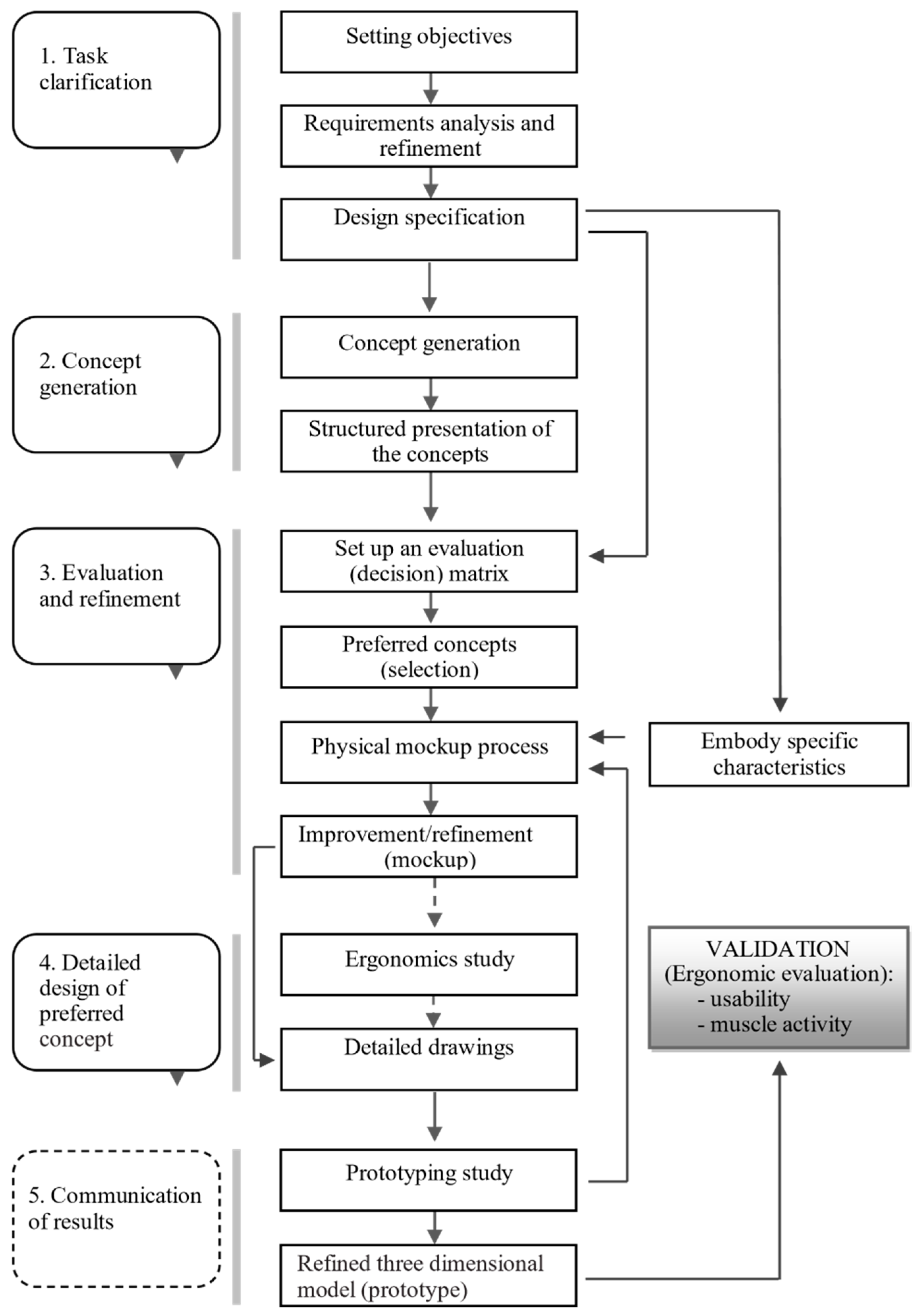

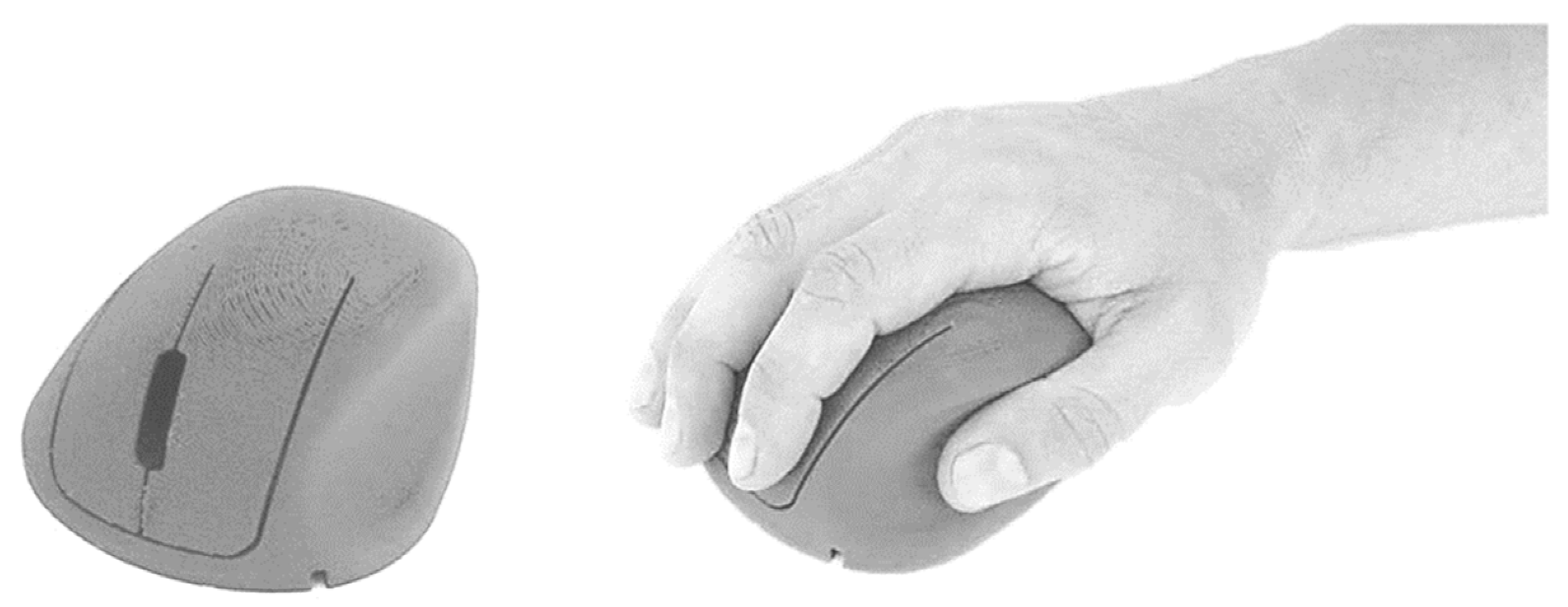
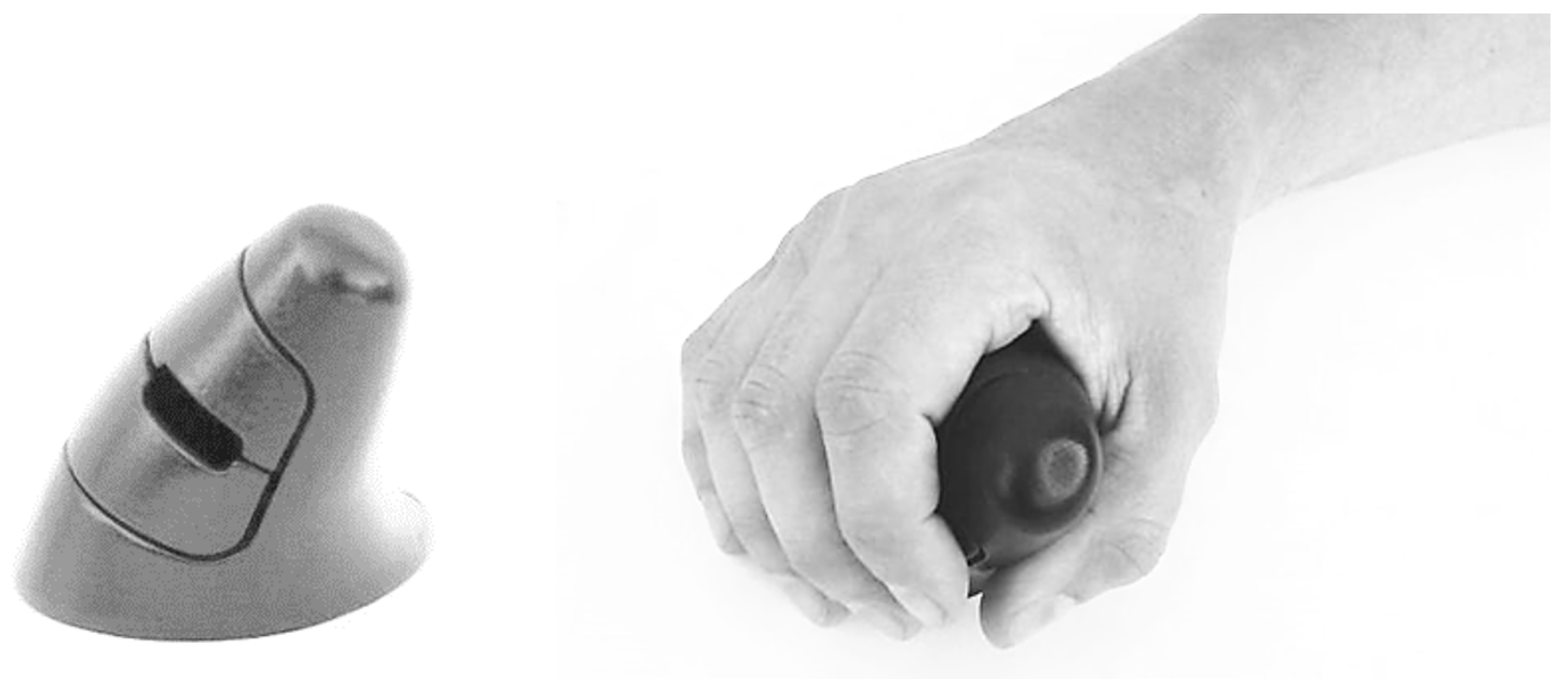
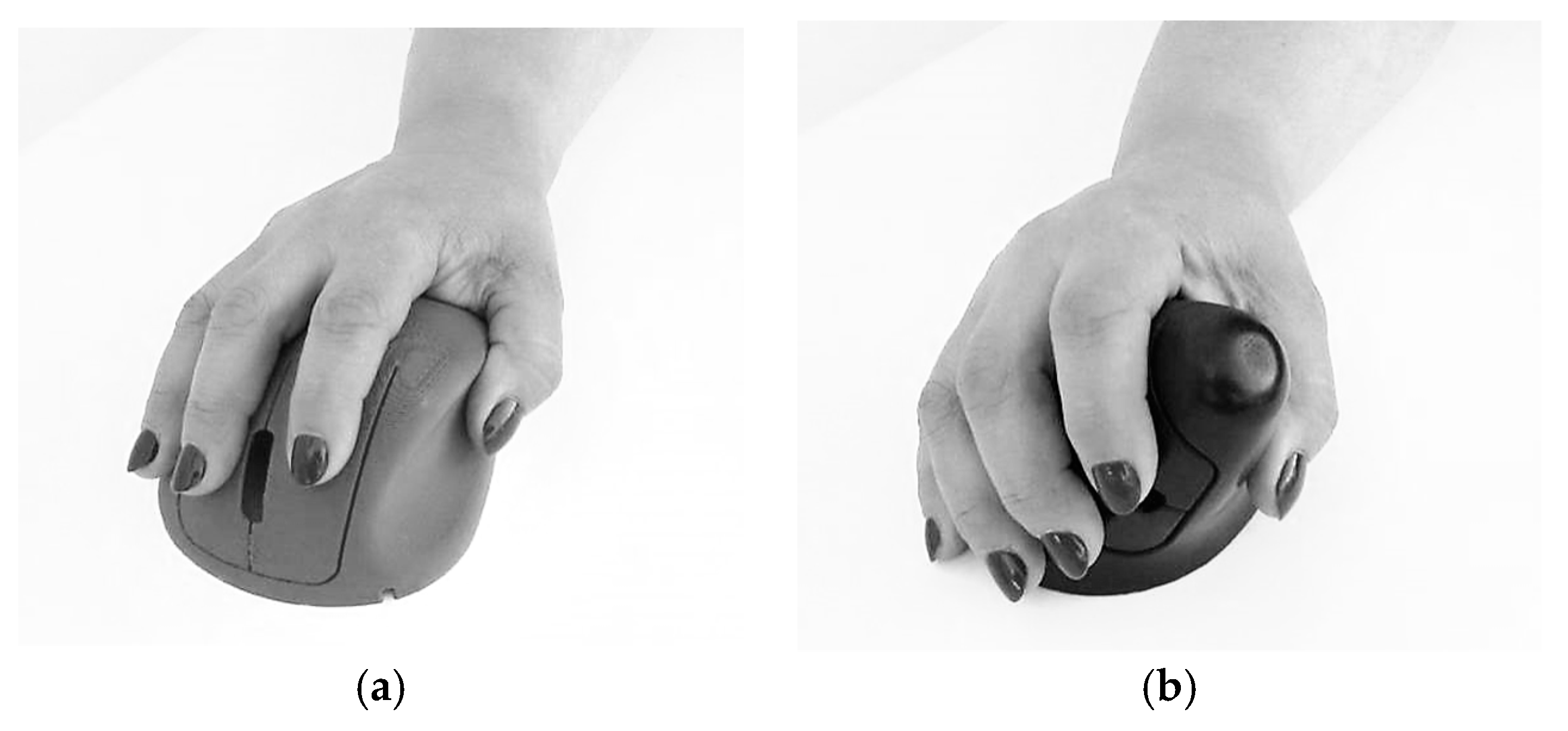

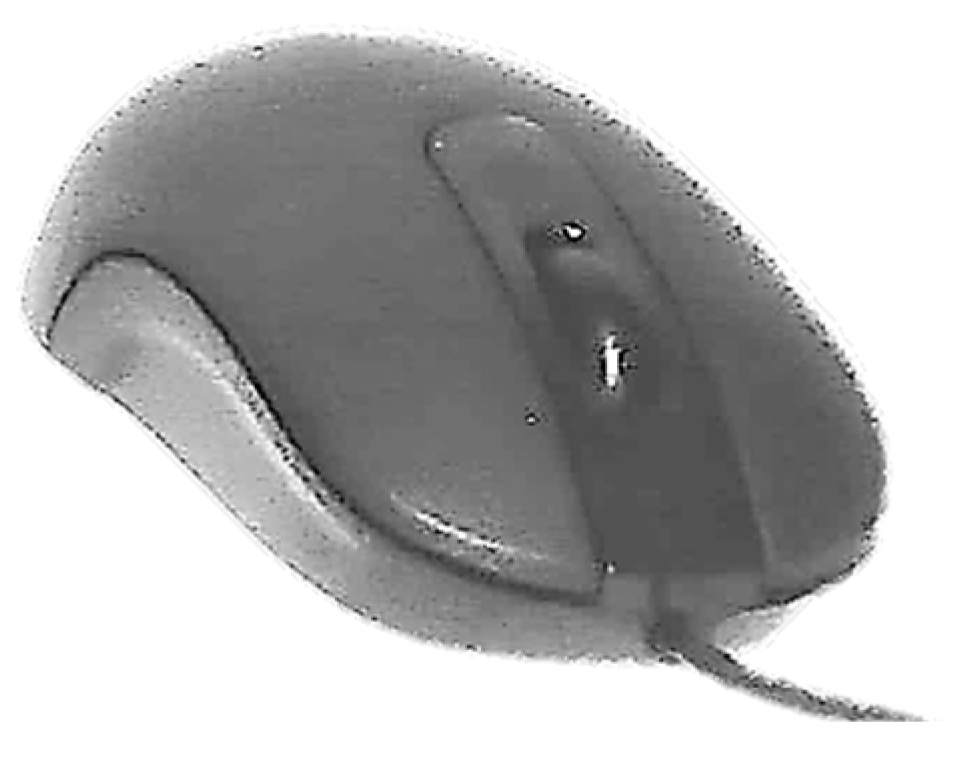


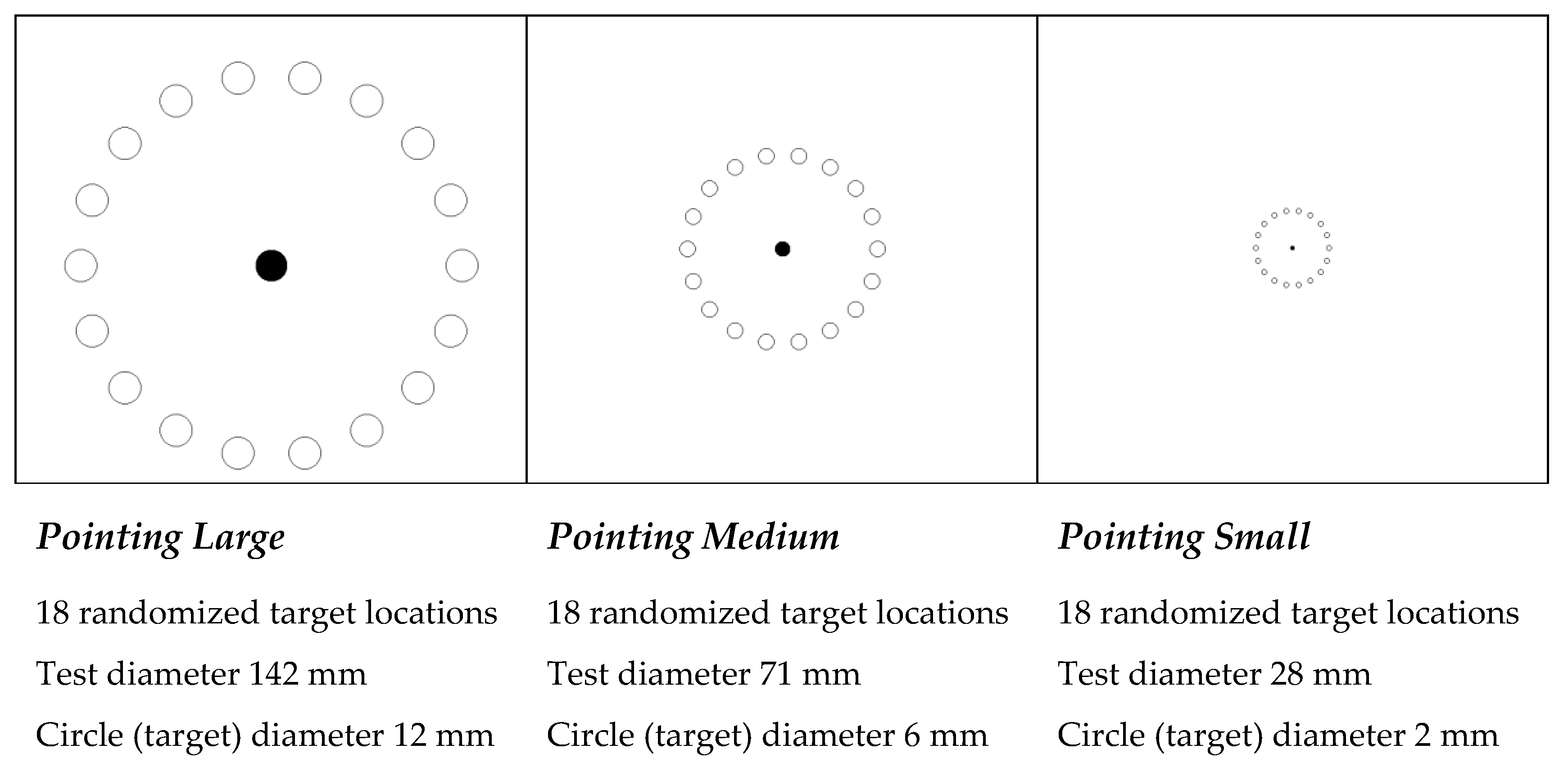

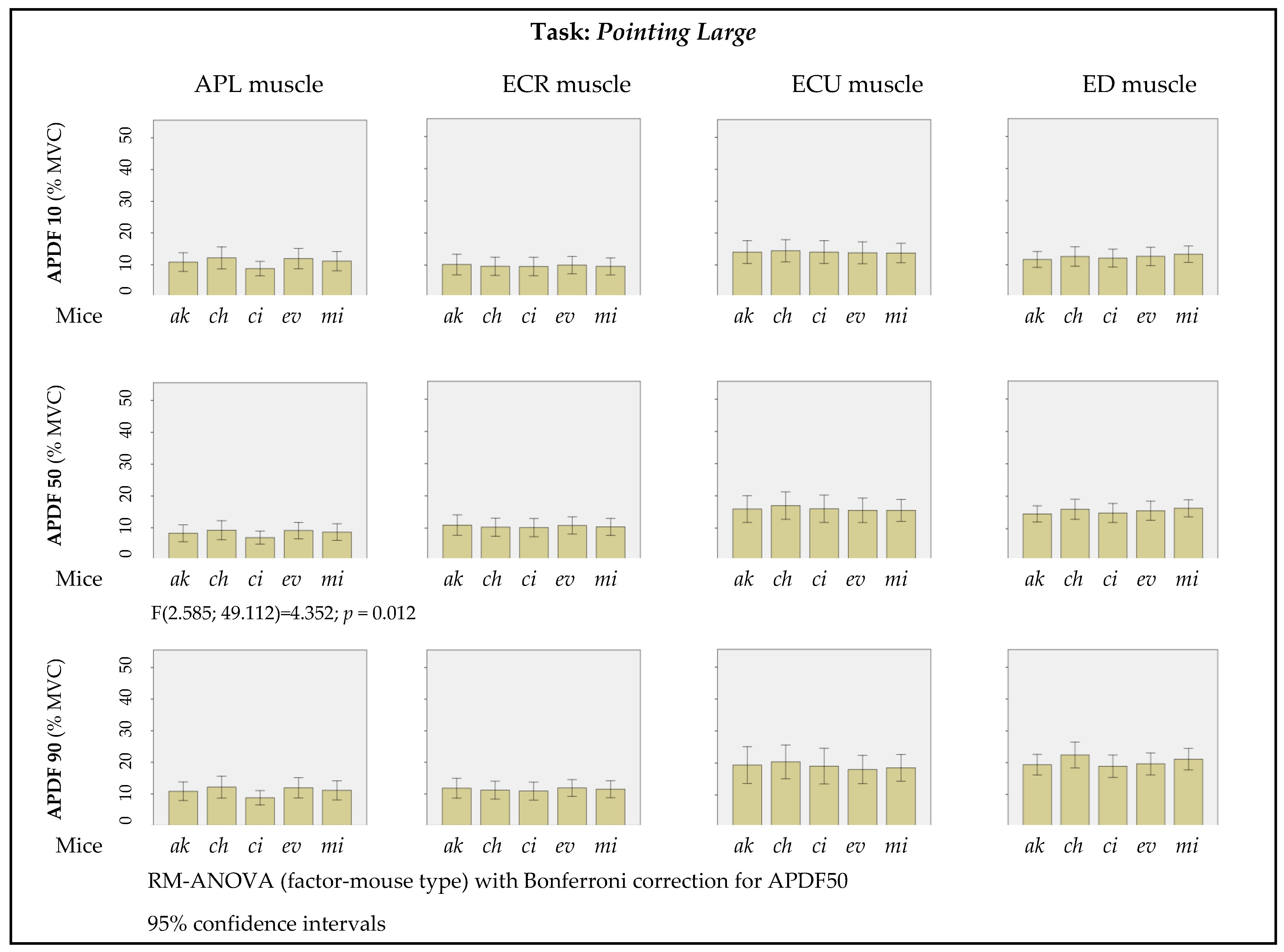
| Main Scope | Requirements and Recommendations |
|---|---|
| User posture-related and anthropometric-related requirements and recommendations | The device should be operated by the user without undue deviation of the hand, fingers, arm, shoulder, and head from their respective neutral positions. |
| The device should be operated by the user without excessive effort; hence, the biomechanical load shall be minimized and the device shape shall take into consideration the minimizing of static muscle load. | |
| The device should minimize the need for extreme positions such as wrist extension, radial or ulnar deviation, and forearm pronation. | |
| The wrists and forearms should be near their neutral postures, avoiding wrist and finger extension; the most comfortable hand gestures are those where the wrists are kept straight, and the fingers are slightly flexed (gently curved) or in a loose fist. | |
| The device shape and the buttons’ locations should minimize finger extension or other movement or positioning that could cause finger strain or static load of the extensor muscles of any fingers. | |
| Input devices should be designed to accommodate the hand size of the intended user population. | |
| Usability-related and innovation-related requirements and recommendations | The weight and inertia of the device should not degrade the accuracy during its use. |
| The input device should be designed to be resistant to inadvertent button activation during its use, and it should be possible to press the buttons on the mouse without reducing control of the device. | |
| The device should promote an intuitive interface, adapting to skills already acquired, to minimize the learning threshold, and optimizing for perceived comfort. | |
| The input device should be effective, efficient, and satisfactory for the task being performed and the intended work environment. | |
| The intended use of an appropriately designed input device for a primitive task (such as pointing, selecting, and dragging) is either obvious or easily discovered. | |
| Buttons should be shaped to assist finger positioning and button actuation. | |
| Buttons should have a displacement force within the range of 0.5 N to 1.5 N until actuation, and should have a minimum displacement of 0.5 mm and maximum of 6 mm. | |
| The motion sensing point should be located under the fingers (precision grip posture) rather than under the palm of the hand. | |
| Grip surfaces should be of sufficient size, shape, and texture to prevent slipping. | |
| The device shall enable anchoring some part of the fingers, hand, wrist, or arm on it or on the worksurface, to create a stable relationship between the hand and the point of action. | |
| The new geometry should be innovative. |
| Rating Criteria (Factor) | Weight | Concept | |||||||
|---|---|---|---|---|---|---|---|---|---|
| pg | pt | ch | ci | ||||||
| Score | Rating | Score | Rating | Score | Rating | Score | Rating | ||
| The use of the PC mouse shall enable anchoring some part of the fingers and/or the hand | 1 | 4 | 4 | 2 | 2 | 2 | 2 | 3 | 3 |
| The use of the PC mouse should minimize ulnar and radial deviation of the hand | 3 | 3 | 9 | 1 | 3 | 2 | 6 | 3 | 9 |
| The use of the PC mouse should minimize wrist extension and wrist flexion | 3 | 4 | 12 | 2 | 6 | 2 | 6 | 3 | 9 |
| The use of the PC mouse should minimize forearm pronation and forearm supination | 3 | 1 | 3 | 2 | 6 | 3 | 9 | 4 | 12 |
| The shape and location of the buttons should minimize finger extension and finger strain | 3 | 4 | 12 | 4 | 12 | 4 | 12 | 4 | 12 |
| The PC mouse’s shape should be designed to accommodate the hand size of the intended user population | 2 | 2 | 4 | 1 | 2 | 2 | 4 | 3 | 6 |
| The hand (fingers) should keep slightly flexed (gently curved) or in a loose fist when grasping the device | 2 | 3 | 6 | 3 | 6 | 3 | 6 | 4 | 8 |
| The PC mouse’s shape should avoid discordant adjacent fingers postures (middle finger, ring finger, and pinky) | 2 | 3 | 6 | 4 | 8 | 4 | 8 | 3 | 6 |
| The PC mouse’s shape and the buttons’ locations should avoid finger extension when clicking, or static load of the extensor muscles of any fingers | 3 | 3 | 9 | 2 | 6 | 3 | 9 | 3 | 9 |
| The PC mouse’s shape should facilitate the implementation of the most suitable buttons | 3 | 1 | 3 | 3 | 9 | 4 | 12 | 2 | 6 |
| The motion sensing point should be located under the fingers (precision grip posture) | 2 | 1 | 2 | 4 | 8 | 4 | 8 | 3 | 6 |
| The PC mouse’s center of gravity should be situated on the grasp axis regarding handle grasp | 2 | 2 | 4 | 2 | 4 | 3 | 6 | 3 | 6 |
| The PC mouse should adapt to skills already acquired | 1 | 2 | 2 | 3 | 3 | 4 | 4 | 3 | 3 |
| The physical characteristics of the PC mouse should conform to the established stereotypes | 1 | 1 | 1 | 3 | 3 | 4 | 4 | 2 | 2 |
| The PC mouse should promote an intuitive interface | 1 | 2 | 2 | 3 | 3 | 4 | 4 | 3 | 3 |
| The new PC mouse geometry should be innovative | 1 | 4 | 4 | 2 | 2 | 2 | 2 | 4 | 4 |
| Total weighted score | 83 | 83 | 102 | 104 | |||||
| Participants | Age (Years) | |||
|---|---|---|---|---|
| Number of Participants | Sex | CAD Practicioner | Mean (SD) | Range |
| 10 | Female | 10 | 23.1 (2.7) | 20–29 |
| 10 | Male | 10 | 25.4 (2.6) | 22–30 |
| Geometries (Slant Angle) | Favourable Salient Aspects | Unfavourable Salient Aspects |
|---|---|---|
| ev 90 deg | Neutral forearm posture (balanced between supination–pronation) | Lowest pointing and clicking efficiency (highest rate of errors in inexperienced use) |
| ak 60 deg | Best compromise between usability tests and electromyographic analysis performed | Shark fin geometry—not inclusive (restrictive hand sizes) |
| ci * 45 deg | APDF50 APL best of the tests (pointing large) | Buttons are hidden by the body of the PC mouse (medium error rate in inexperienced use) |
| ch * 30 deg | High pointing and clicking efficiency (low rate of errors in inexperienced use); thumb support included in the geometry | Low pointing and clicking efficiency (high rate of errors in inexperienced use) |
| mi 0 deg | Highest pointing and clicking efficiency (lowest rate of errors in inexperienced use) | Full pronation of the forearm |
Publisher’s Note: MDPI stays neutral with regard to jurisdictional claims in published maps and institutional affiliations. |
© 2022 by the authors. Licensee MDPI, Basel, Switzerland. This article is an open access article distributed under the terms and conditions of the Creative Commons Attribution (CC BY) license (https://creativecommons.org/licenses/by/4.0/).
Share and Cite
Lourenço, M.L.; Pitarma, R.A.; Coelho, D.A. A Design Contribution to Ergonomic PC Mice Development. Int. J. Environ. Res. Public Health 2022, 19, 8126. https://doi.org/10.3390/ijerph19138126
Lourenço ML, Pitarma RA, Coelho DA. A Design Contribution to Ergonomic PC Mice Development. International Journal of Environmental Research and Public Health. 2022; 19(13):8126. https://doi.org/10.3390/ijerph19138126
Chicago/Turabian StyleLourenço, Miguel L., Rui A. Pitarma, and Denis A. Coelho. 2022. "A Design Contribution to Ergonomic PC Mice Development" International Journal of Environmental Research and Public Health 19, no. 13: 8126. https://doi.org/10.3390/ijerph19138126
APA StyleLourenço, M. L., Pitarma, R. A., & Coelho, D. A. (2022). A Design Contribution to Ergonomic PC Mice Development. International Journal of Environmental Research and Public Health, 19(13), 8126. https://doi.org/10.3390/ijerph19138126







